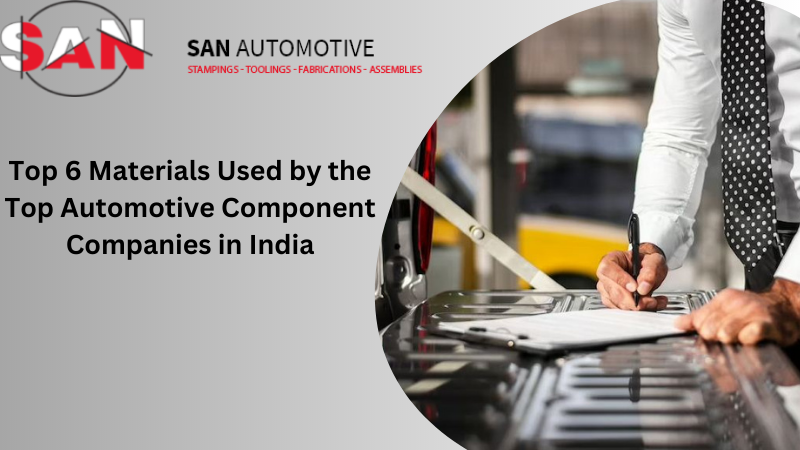
Automotive components require a large number of materials for their production, and most materials are chosen as per the nature of their application in an assembly. As for major materials chosen by the best automotive component companies in India, they include aluminium, stainless steel, glass and iron ore to make steel, rubber, and special fibres. Once the raw materials are mined from the earth, they are transformed into different shapes and sizes to be used by automotive stamping companies in India and the world. The automotive industry is one of the world’s largest consumers of raw materials extracted from earth.
Hundreds of components are used for the assembly of an automobile. Engine and transmission are just the basic building blocks of an assembly, and a large number of components are also used beyond them. There are so many interior parts that include HVAC systems, instrument panels, seats, and very specific wiring to tie everything together. Over the past few years, the materials used to make such components have seen a drastic change. But the end product as a whole remains almost the same.
This blog sheds light on some of the major materials that are used to forge automotive components:
Steel
The way steel is produced has witnessed a great improvement over the past 10-15 years. Different areas and parts of a car or an automobile call for different materials as per the application requirements. Steel is the primary material used to make the following parts of cars:
-
Door panels
-
Chassis
-
Support beams
-
Exhaust pipes, and
-
Mufflers.
However, due to the unmatched benefits that steel offers, it is mostly used on the frame of the car. What it simply means is that steel offers better impact absorption ability. On average, a car has around 2400 pounds of steel whereas an SUV has around 3000 pounds of steel. It is the construction material used that determines the overall weight and support system of a car, intending to keep the users safe and worry-free from the hassles on the way.
Plastic
Petroleum by-products (oil and gas) are also an inseparable part of automobile manufacturing. To some extent, plastics have become a great challenger to steel because of their growing use in automobile manufacturing for a large number of reasons. Plastics are malleable and still offer sturdiness to keep any assembly or structure in shape. Needless to say, plastics make up almost 50% of the total car parts. They are used mainly to manufacture air vents, pipes, dashboards, and door handles of cars. Over the past few years, producing lightweight automobile products has been a tough challenge before the automobile manufacturers and plastics have come to the rescue because it is extremely lightweight when compared to other materials such as steel and aluminium. The attributes and characteristics of plastics such as versatility, quality, durability, lightweight, and robustness make it an ideal material to make cars and other automobiles.
Aluminum
Aluminium among other metals used for automobile manufacturing is also heavily used to manufacture some specific parts of an automobile due to its lightweight yet sturdy performance. Aluminium being malleable is one of the most common materials used for car manufacturing. Dating back to 1970, this metal used to be accounted for only 2% of the total parts of an automobile but as of now, it is being used in more than 15% of parts of cars and other vehicles. For example, wheels are the most essential parts of a car, and earlier steel was used to make them. But now aluminium has replaced steel completely for the production of wheels. Though aluminium as a metal is never considered as durable as iron or steel, it is still popular because of its lightweight resulting in improved performance of the vehicle. Aluminum has also helped OEMs to reduce the overall weight of the vehicle which in turn has given a great boost to performance.
Rubber
Rubber is also one of the most prominent materials comprehensively used in the manufacturing of automobiles around the globe. Being cheap, durable, and flexible, rubber is used to manufacture wiper blades, belts, engine mounts, and hose seals. Rubber as an automobile manufacturing material is well known to function well in a wide variety of parts with an incredible capability of handling the heat in case the vehicle heats up beyond the standard limits. It might as a surprise for many that a large percentage of rubber produced around the globe finds applications in the manufacturing of automobiles. The manufacturers’ community is working hard to introduce innovations to make the use of rubber more meaningful in different vehicles.
Fibreglass
Most people are not able to make a difference between glass and fibreglass. Both are different materials. Fibreglass is made up of extremely thin strands of fibreglass, and as a whole, it is mostly air and not glass. Fiberglass has proven to be of immense significance to the automotive industry. It is a non-corrosive material and helps replace steel for a large number of applications in areas where steel corrodes very easily. Another salient feature of fibreglass is that it is fireproof and gives the users scope to come out of the car in the occurrence of accidents. Fibreglass is heavily used in roofs, casings, doors, front bumpers, and the wheels of vehicles. Its uses are increasing day by day in the automotive industry across the globe.
Concluding Remarks
SAN Automotive is one of the leading automotive component companies in India with a presence of more than 22 years within the industry. The company has earned a formidable reputation in both national and international markets by forging automotive components that offer quality, durability, and reliability. On the front of innovation and research, the company has been constantly successful in introducing various ‘first-time’ products or components for its customers across the globe. SAN Automotive considers people its real assets and invests them by going beyond the call of duty apart from continuously developing a robust infrastructure.